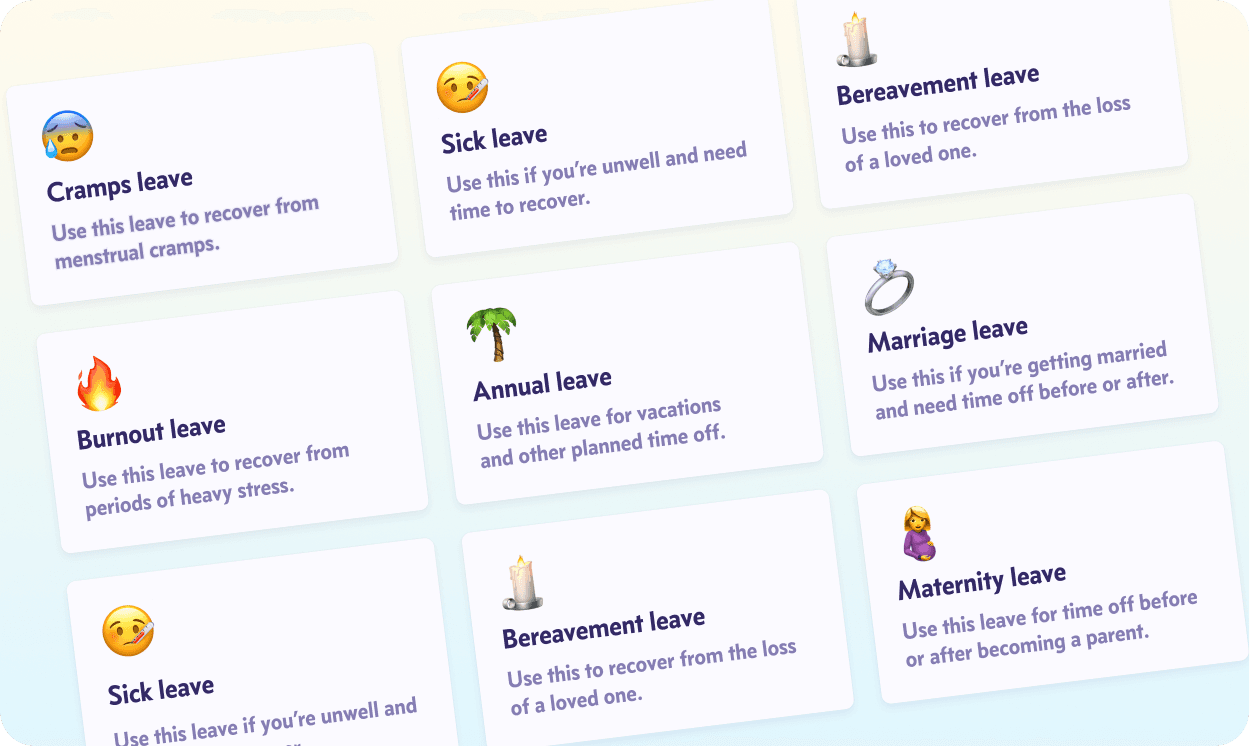11 types of leaves every company should include in their leave policy
Nov 23, 2021

Labour laws have come, gone and changed their get up — and that's also the case with time off. The notion of paid time off has evolved from something mandated by law to a perk that organisations willingly offer. Apart from the usual expectations, new entrants like menstrual leave and duvet days ensure that employees prioritise every aspect of their life.
When it comes to setting up a leave policy, the devil is in the details. All these types of leave can be confusing — but we're here to cut through the clutter and help you identify what to include. This way, you have a clear, empathetic and inclusive leave policy that works for who it's supposed to: the employees!
Types of leave to include in your leave policy: Mandatory
Mandatory types of leave form the ideal foundation for your leave policy. You can build on them as your company grows to make your policy more inclusive and accommodating.
Earned Leave
Earned leave is what it says on the tin: leave days that you "earn" based on the number of days you work. They're also referred to as vacation leave, privilege leave, or annual leave. Some earned leave rules—like the maximum number of leave days—differ based on state and labour laws. The standard number, though, is 20 earned leave days, and this doesn't include public holidays or weekends!
There's another unique feature of earned leave: they can be carried forward into the next year if they go unused, or converted into cash through leave encashment. But again, the cap on the number of days an employee can carry forward or encash depends on labour laws and organisational decisions.
It's worth mentioning that many organisations don't need employees to "earn" their time off any more. Instead, many credit these leave days under the Annual Leave category.
Casual Leave
Casual Leave, or CL, is an additional type of leave that companies might offer in addition to earned leave. They're meant to accommodate unforeseen circumstances and emergencies, such as urgent repair work at home. The standard number is 9-14 days.
If organisations don't offer casual leave, it's probably because they've combined it with earned leave. After all, this reduces the types of leave to write guidelines around!
Sick Leave
This one's a no-brainer: It's a type of leave employees can take when they're ill or in the case of accidents. This is a pretty common leave type because it's mandated by law in many states. The number of sick days that organisations can choose to offer is usually between 9 and 14 days.
Oh, and by the way: Many organisations ask employees to submit a medical certificate if they take more than 3 days of sick leave. This is to prevent misuse. However, a growing number of employers are choosing not to, in a show of trust in their employees.
Maternity Leave
Maternity Leave is mandated by the Indian Government. Under the Maternity Benefit Act of 1961, employees need to provide 26 weeks of paid leave to any woman who has worked for at least 80 days in the 12 months before their expected delivery date, up to two children. In the case of a third child, the new mother can take 12 weeks of paid leave. It's worth noting that the Act also mandates paid leave in the case of adoption, surrogacy, tubectomy and miscarriages.
Types of leave to include in your leave policy: Nice to have
These leave types aren't required by law in many countries, but they're definitely empathetic and people-centric. You'd be hard-pressed to find an organisation today that doesn't have a few of these leave types in their policy!
Paternity Leave
As an employer, you might want to encourage the active role of fathers by offering paid leave to new fathers. This is called Paternity Leave. It usually applies to biological or adoptive fathers of the child or the mother's husband or partner.
Organisations get to decide how many weeks to offer a new father. It starts from 4 weeks but many workplaces, like Obvious, offer up to 8 weeks' paternity leave with full pay.
💡 Did you know: Pawternity Leave (or Furternity Leave) is just like parental leave, except for pets! This type of leave came about in response to the many employees bringing pets into their families and needing time off to settle them in.
Compensatory Off
Comp-off (also known as compensatory leave and com-off) is what an employee can take if they end up working on a non-working day, like a holiday or weekend, to meet a deadline.
Since it's approved on a case-by-case basis, there usually isn't a set number of comp-off days to allot. However, some organisations choose to set an expiry date of 2-4 weeks so that there are no sudden shocks while capacity planning.
Bereavement Leave
This leave type is intended to be used if an employee has a death in the family. It accounts for the time employees would need to grieve, prepare funeral rites, and generally take care of family affairs. To that end, bereavement leave usually stretches into 2 or more weeks.
It's common practice for some workplaces to offer compassionate leave instead, because it accounts both for bereavement and in case an employee has to take care of a sick or dependant relative. This is much more empathetic because it takes into account an employee's role as a caregiver at home, too.
Leave Without Pay
What happens when an employee has used up all their assigned leave days in a year? They're entitled to Leave Without Pay (LWP) or Loss of Pay Leave (LOP). This means they can take time off, but they'll lose that day's income from their monthly salary.
Given how generous leave policies can be, this is usually a rare case. However, it's still worth documenting in your leave policy so there are no gaps.
Marriage Leave
If an employee is getting married, this type of leave allows them to take a few days off for that occasion. Marriage leave is mandatory in some countries around the world, including Vietnam and Malta. It can span anywhere between 2 and 15 days, although the common quantum is 3 days.
Marriage leave often comes with its own set of rules. Some HR teams may ask for a wedding invitation as proof. In other workplaces, employees can claim this type of leave only for their first legal marriage, or only once during their entire employment period.
Menstrual Leave
Here's an example of the types of leave changing with the times: menstrual leave! People who menstruate can claim this leave type (also called period leave) if they're unable to go to work on their period days. It acknowledges that menstrual pain and its symptoms affect productivity, and encourages people who menstruate to take time off and rest.
Most organisations that offer this type of leave don't have a maximum cap on it, and account for it being a monthly allowance. However, others choose to specify the number of days available per month.
Duvet Days
Duvet days are a fairly new concept, mostly offered in the United Kingdom and the United States. It is an allowed amount of time that an employee can take without giving any prior notice. These days are usually taken when an employee feels burnt out or needs to recharge their batteries, and can come at sudden notice.
Duvet days have the potential to improve employee wellbeing and productivity. However, if you're offering this type of leave, it's important to ensure proper team communication. This is where a tool like Pause can help. Pause sends immediate notifications to the team on a common Slack channel when someone takes time off either in advance or on the day off. This can help colleagues offset most of the damage that might've occurred with an unscheduled leave.
Public Holidays
Okay, so this isn't a leave type, but it's still worth accounting for in your leave policy. Public holidays are mandatory off days usually specified at a government level. Naturally, these differ depending on the state and country your organisation is in.
Public holidays can be customised to balance the number of leave days you offer in other leave categories. You can also list some public holidays as optional, so those who celebrate can claim them, while those who don't can treat it as a normal working day. This is especially useful in diverse and multi-cultural workplaces.
Define types of leave clearly with a leave management software
Keeping track of all these types of leave can be an overwhelming task — but not if you use leave management software to do it!
Pause helps you set up customised leave policies for your organisation in a few simple steps. You can specify the number of days per category, approval methods, and details required. When employees apply for leave, they'll see a description of the leave type so they aren't confused, along with their leave balance so they don't overbook themselves.
Ready to start your free trial? Head here!


